26 Best Fall Flowers for Pots and Container Gardens
Stunning Blooms That Thrive in Cooler Weather
Reviewed by Debra LaGattuta
Many plants that thrive in the garden during cooler weather also make great fall flowers for pots and containers. Good candidates for fall planters' flowers are plants with a genetic disposition to autumnal blooming or a long-lasting bloom period that extends into the season. Good tolerance for the cooler fall temperatures is also essential; many heat-loving species do not thrive in the fall.
The time of year to plant fall flowers varies tremendously. Some are planted in spring, growing all season until the first frost. Others are best to plant in mid or late summer or early fall.
Traditionally, containers and hanging baskets are planted with vigorous-blooming annual flowers, but increasingly, gardeners are using traditional garden perennials in their container garden designs. While plant species have varying soil needs when grown in garden settings, most plants do well in containers filled with ordinary general-purpose potting soil.
Here are 26 good ornamental plants to consider for your fall container gardens.
Coral Bells (Heuchera cultivars)
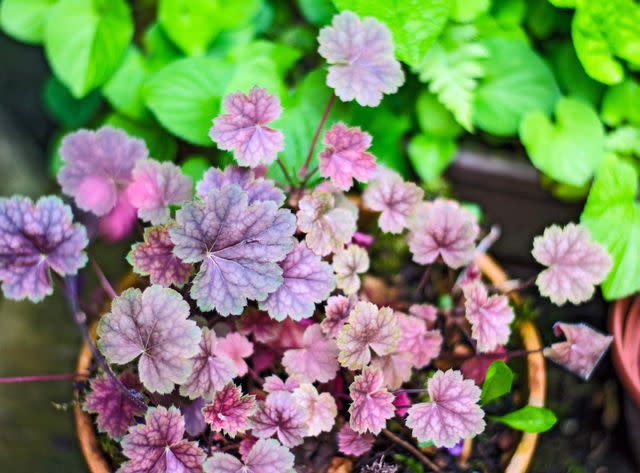
retrofutur / Getty Images
Coral bells, a long-favored garden species, have also become a favorite container plant. These perennial plants come in various colors and leaf textures and are almost impossible to kill. Coral bells is a mounding plant, and it looks great on its own, paired with contrasting plants or plants that offer varying shades of the same color. Coral bells work exceptionally well with gourds, mums, and ornamental grasses. Choose a dark, almost black leaf, like 'Dolce, Licorice' or the lighter 'Dolce, Peach Melba' for a terrific fall plant that works well with many fall decorations. They also look lovely when paired with pumpkin planters.
USDA Hardiness Zones: 4 to 8
Flower Color Varieties: Red, white, coral, pink
Light: Full sun to partial sun
Soil Needs: Moist, loamy soil
Deer Resistant: Yes
Verbena (Verbena spp.)
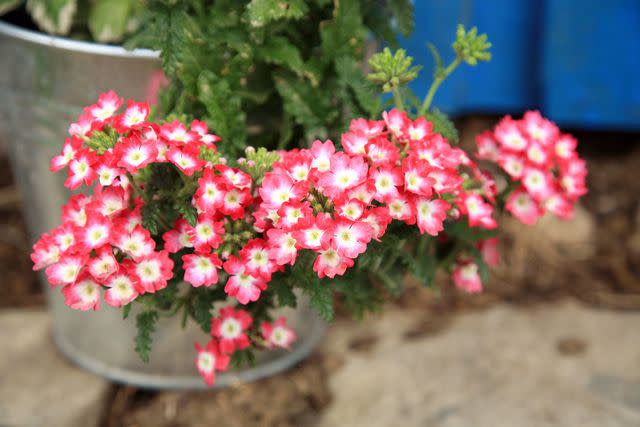
fotokate / Getty Images
Verbena is a large genus of prolific-blooming species, but the varieties most often grown in containers are shorter types usually grown as annuals. They are suitable fall flowers based on a long bloom period and their tolerance for cool temperatures. Many verbenas are hardy down to 15 degrees Fahrenheit and will continue flowering even after the first frost. Verbenas look great either on their own or filling in spaces and spilling over the edges of garden planters, window boxes, or hanging baskets. Colors range from white to brilliant reds to deep dark blue to purples and pinks.
USDA Hardiness Zones: 5 to 11
Flower Color Varieties: White, pink, red, peach, lavender, blue, purple
Light: Full sun
Soil Needs: Acidic soil
Deer Resistant: Yes
Oxalis or Shamrock (Oxalis regnellii)

A warm-weather perennial generally grown as an annual, oxalis is elegant and cheerful. It is exceedingly easy to grow and likes partial shade to full shade. Oxalis is a mounding plant that grows 12 to 18 inches high, making it an excellent plant to use as a filler in a container. It comes in several colors, including a nearly black, 'Charmed Velvet,' and a burgundy color called 'Charmed Wine.' Another nice feature about oxalis is that you can bring it indoors to overwinter.
USDA Hardiness Zones: 8 to 11
Flower Color Varieties: Mauve, pink, lavender, pinkish-white
Light: Partial shade
Soil Needs: Well-draining soil
Deer Resistant: Yes
Ornamental Cabbage and Kale (Brassica oleracea)
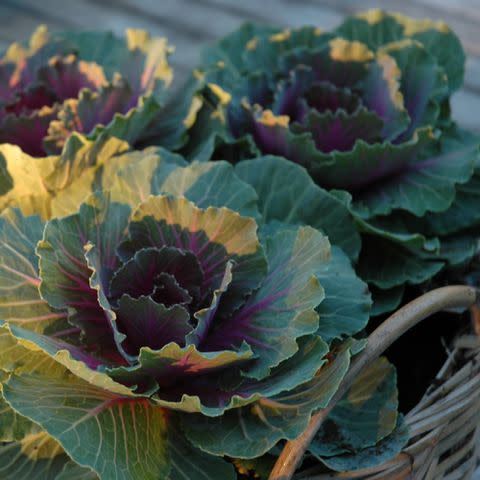
Ornamental cabbages are chubby and cheerful plants, while the kales are spiky. However, these plants will take you well into fall with style and beautiful sage greens blended with pinks and purples. As a bonus, flowering cabbage and kale colors only intensify as the weather gets colder, especially after a frost. Cabbages are excellently grouped in either rustic garden planters or low baskets. They also bring great color and texture to mixed container gardens. Kales can look great in funky shallow baskets, window boxes, or modern metal planters with clean lines. These are bold plants, so don’t be afraid to plant them in unusual containers or combine them with unlikely companions.
USDA Hardiness Zones: 2 to 11
Leaf Color Varieties: Ornamental leaves in purple, rose, and cream
Light: Full sun to partial shade
Soil Needs: Loamy soil
Deer Resistant: No
Sedum (Sedum, Hylotelephium spp.)
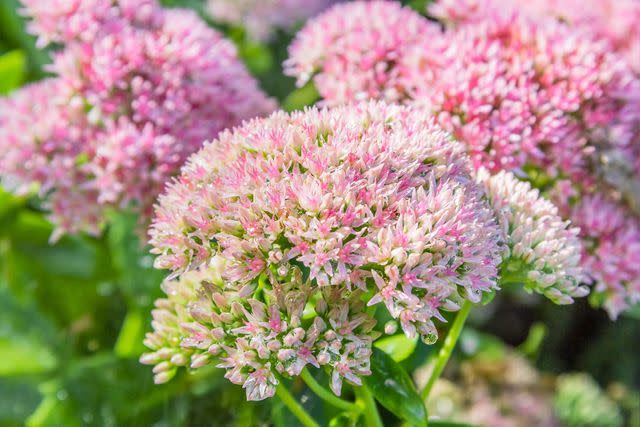
HaiGala / Getty Images
The large Sedum genus recently was split, with 33 species reassigned to the Hylotelephium genus). This included standard favorites such as 'Autumn Joy,' now known as Hylotelephium 'Herbstfreude' Autumn Joy. However, they are all still generally known by the common name of sedum or stonecrop.
Many fall-blooming Sedum (or Hylotelephium) species are classic plants for fall container gardens. In late summer to early fall, sedum is easy to grow in containers, and there is a vast array of species and cultivars with different heights, textures, and flower forms. If you want to overwinter a fall container outdoors, sedum is a perfect choice because the dried flowers can look beautiful, mainly covered with snow or frost. Some varieties can grow tall and are great to use in the center or back of a container.
USDA Hardiness Zones: 3 to 10
Flower Color Varieties: Pink to mauve
Light: Full sun
Soil Needs: Average soil with good drainage
Deer Resistant: Occasionally
Tip
Choose plants like sedum that can overwinter with continuously interesting flowers and foliage to keep your garden interesting even in winter.
Garden Mums (Chrysanthemum morifolium)
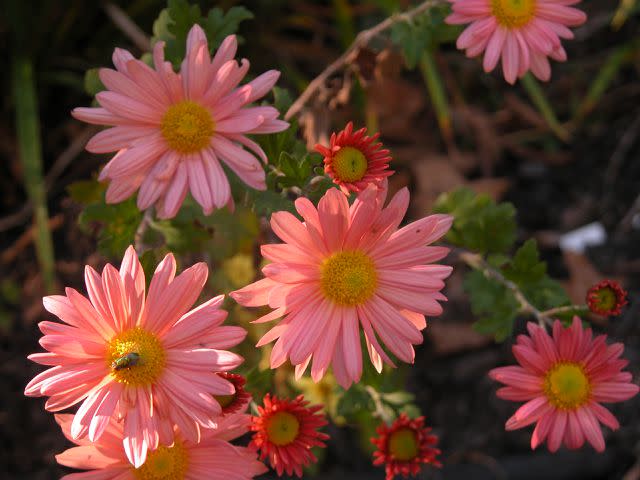
The potted garden mums sold so prevalently for fall display are typically forced into late bloom by commercial growers, who keep them closely pruned until late July, waiting until early fall to display them for sale at nurseries. If you are growing potted mums from transplants purchased in the spring, they will likely bloom in mid to late summer unless you pinch off all buds and keep the shoots pruned back. If you stop pruning in early July, the plants will likely flesh out and bloom in September.
Although they are perennials, mums are more typically grown as annuals, discarded after blooming ends with the frost of late fall. But potted mums can sometimes be overwintered if you cut back the shoots and place them in a sheltered location over the coldest months. Put the pots back into a warm, sunny spot in spring, and keep them closely pruned again until mid-summer.
USDA Hardiness Zones: 4 to 9
Flower Color Varieties: Lavender, maroon, purple, white, yellow, coppery orange
Light: Full sun
Soil Needs: Moist, well-drained soil
Deer Resistant: Occasionally
Asters (Aster spp.)
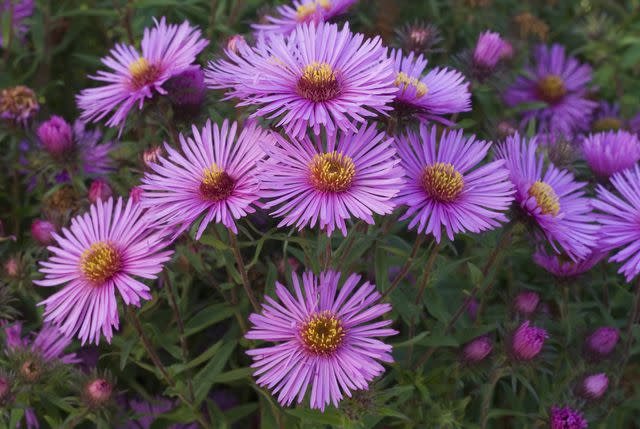
Aster's blue or indigo purple flowers symbolize the fall garden and can work equally well in a fall container garden. Because most types grow rather tall—as much as 6 feet—these are plants best suited for huge containers. As container plants, they do best when planted in rich soil and kept moist but not soggy. After flowering, cut the stems back entirely and store the potted plants in a cold frame or greenhouse.
USDA Hardiness Zones: 3 to 9
Flower Color Varieties: Violet or blue with yellow centers
Light: Full sun
Soil Needs: Medium, well-drained soil
Deer Resistant: Yes
Pansies (Viola × wittrockiana)
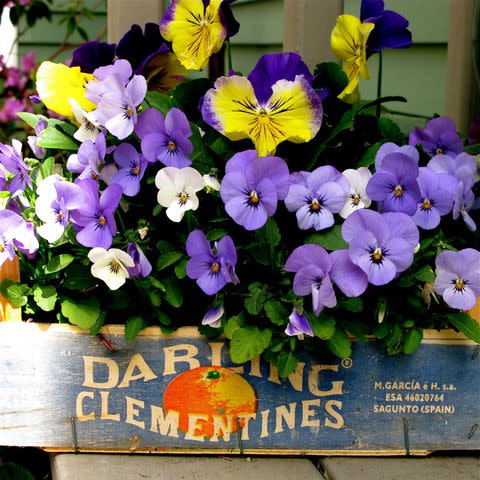
Kerry Michaels
Pansies are classic cool-weather annuals that typically appear in the early spring garden, but they can be planted again for the fall after the weather has cooled. Pansies don't do well in the hot months of mid-summer. They need fairly moist soil, so water them frequently when growing them in containers or hanging baskets.
USDA Hardiness Zones: 6 to 9
Flower Color Varieties: Many shades of blue and purple, rose, yellow, orange, maroon, white; solid and bi-colors, often with darker centers
Light: Full sun to part shade
Soil Needs: Moist, well-drained soil
Deer Resistant: No
Black-Eyed Susan (Rudbeckia)
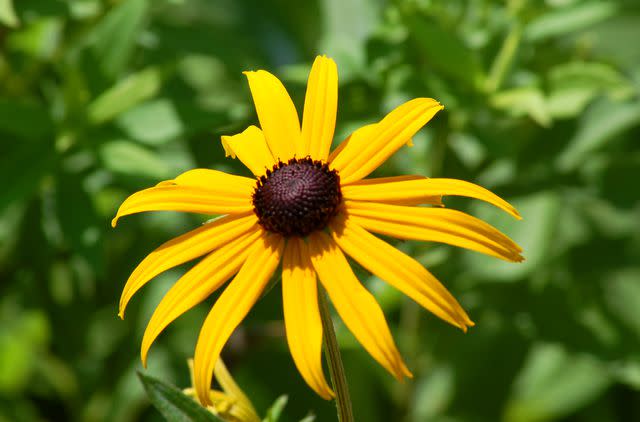
Black-eyed Susan is a traditional perennial daisy that can be grown in containers and in the garden. It blooms from mid-summer to late fall and can be overwintered if the containers are sheltered for the cold months. Unlike many perennials, black-eyed Susans are relatively easy to grow from seed. Use well-drained potting soil.
USDA Hardiness Zones: 3 to 7
Flower Color Varieties: Golden yellow
Light: Full sun
Soil Needs: Average, medium moisture soil
Deer Resistant: Yes
Coneflower (Echinacea spp.)
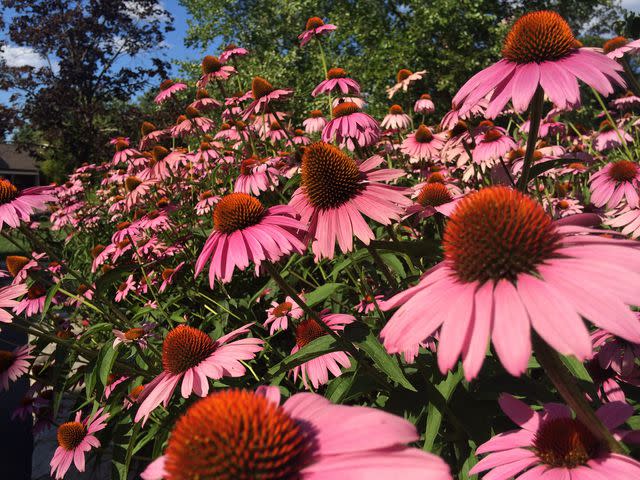
alvaroreguly
The various forms of perennial coneflower are standard fall bloomers in the garden, blooming with daisy-like flowers in late summer that last through the fall, but they can also work well in containers. In most climates, the containers can be moved to a sheltered area to overwinter successfully. Or they can be grown as annuals, planted afresh in containers each spring.
USDA Hardiness Zones: 3 to 8
Flower Color Varieties: Purplish pink, white; other colors such as hot pink, orange, red, and golden yellow have been recently introduced to the market
Light: Full sun to part shade
Soil Needs: Average dry to medium-moisture soil
Deer Resistant: Usually
Million Bells (Calibrachoa group)
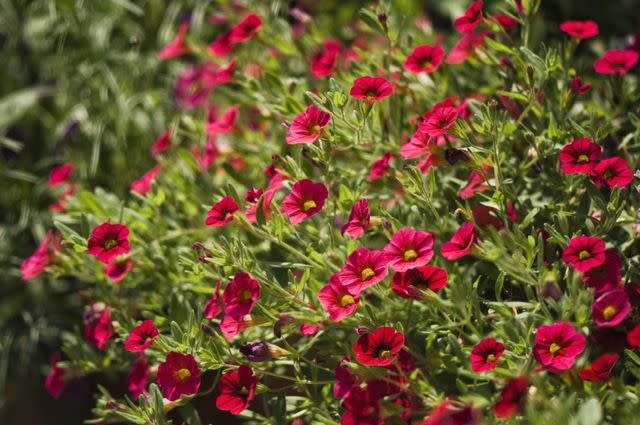
Maria Mosolova / Getty Images
This warm-weather plant is grown as an annual in most climates. This profuse bloomer produces flowers that resemble small petunias (to which it is related) and holds up well as the weather cools in the fall. The million bells plant is often grown in containers than in garden soil. It has a mounding habit that works well with trailing plants in mixed hanging baskets or large containers.
USDA Hardiness Zones: 9 to 11
Flower Color Varieties: Violet, blue, pink, red, magenta, yellow, bronze, white
Light: Full sun
Soil Needs: Rich, well-drained soil
Dear Resistant: Usually
Purple Fountain Grass (Pennisetum setaceum)
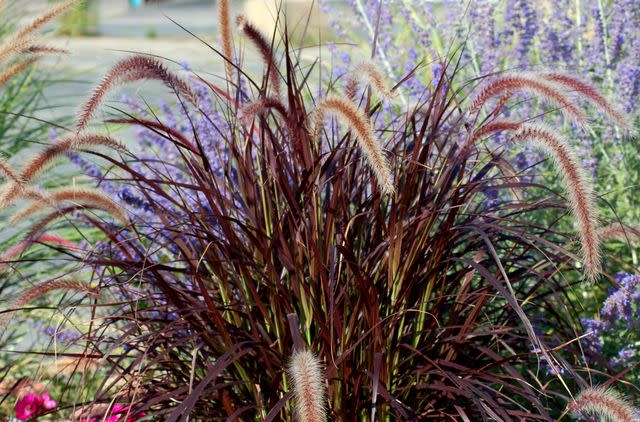
Although not a flowering plant, this ornamental grass makes a good centerpiece for large mixed containers, presented best when surrounded by cascading plants. The stalks are topped with attractive bristling seed heads in late summer, which last well into fall. The plant has an arching, clumping growth habit and grows up to 5 feet tall. Purple fountain grass is a warm-weather perennial often produced annually because it grows quickly from seeds.
USDA Hardiness Zones: 9 to 11
Leaf Color Varieties: Burgundy red
Light: Full sun to part shade
Soil Needs: Medium-moisture, well-drained soil
Deer Resistant: Yes
Dahlia (Dahlia spp.)
Dahlias are late-season flowers that bloom from midsummer through the first frost and grow with much variety in color and sizes. Some can grow up to 6 feet tall. These flowers grow best in full sunlight with moist, well-drained soil. These plants are perennial in warmer zones. In colder areas where the ground freezes, dig up their tuberous roots before they freeze and replant them in the spring. This plant is toxic to cats and dogs.
USDA Hardiness Zones: 8-10
Flower Color Varieties: Red, Pink, Orange, Yellow, Purple, White
Light: Full sun
Soil Needs: Loamy, well-drained
Deer Resistant: No
Petunia (Petunia spp.)
Petunias are fast-growing plants that will reach full size by late spring. They will flower all season as long as they have ample sun, water, and fertilizer. Deadhead spent blooms to keep the plant flowering until the first frost. Prune away scraggly growth to encourage new growth.
USDA Hardiness Zones: 10-11
Flower Color Varieties: Pink, purple, yellow, red, orange, green, white
Light: Full sun
Soil Needs: Well-drained, moist
Deer Resistant: No
Celosia (Celosia spp.)
Celosia or cockscomb produces multiple colored flowers throughout the summer, usually starting to bloom in June and until the cold weather sets in. Deadhead the faded, browning blooms to keep the plant producing flowers all season. These plants require full sun, frequent watering, and well-draining soil.
USDA Hardiness Zones: 3-11
Flower Color Varieties: Purple, pink, white, yellow, red, orange
Light: Full sun
Soil Needs: Moist, well-draining
Deer Resistant: No
Zinnias (Zinnia spp.)
Zinnias look similar to daisies and dahlias, which makes sense since they're in the same Aster family. Zinnas flower from summer to first frost. They thrive more in the hottest and warmer weather but can hold their own until the cold weather sets in. Zinnias do not have to be deadheaded, but their flowers may last longer if you do.
USDA Hardiness Zones: 3-10
Flower Color Varieties: Pink, purple, yellow, orange, white, red, green
Light: Full sun
Soil Needs: Well-draining
Deer Resistant: No
Goldenrod (Solidago spp.)
Goldenrods produce attractive, fluffy golden flower spikes that grow best in a sunny spot. This plant does not like fertile soil, preferring average or poor soil, and thrives in temperatures between 65 to 80 degrees Fahrenheit. Its late-season blooms attract pollinators up through October. Deadhead the fading flowers to extend the plant's bloom season.
USDA Hardiness Zones: 2-8
Flower Color Varieties: Yellow
Light: Full to partial sun
Soil Needs: Average to infertile, well-drained
Deer Resistant: No
Marigold (Tagetes spp.)
Marigolds (Tagetes spp.) are cheerful, reliable, blooming annual flowers. They produce flowers fast from seeds, usually within a few months, lasting the whole season until the first frost. Marigolds vary in size, color, and type—from single-petal flowers to large, double-petal blossoms. Deadheading will keep your flowers more prolific.
USDA Hardiness Zones: 2-11
Flower Color Varieties: Yellow, orange, white, red, gold, bicolor
Light: Full
Soil Needs: Sandy, loamy, evenly moist, well-drained
Deer Resistant: No
Japanese Anemone (Eriocapitella x hybrida)
Japanese anemone, also called windflower or Japanese thimbleweed, features graceful white, pink, or purple blossoms. These easy-to-grow, low-maintenance perennial plants bloom in late summer and early fall. They develop rhizomatous roots that spread and colonize an area. These plants prefer fertile, moist, well-drained soils.
USDA Hardiness Zones: 4-8
Flower Color Varieties: White, pink, purple, lavender
Light: Full to partial sun
Soil Needs: Well-draining, moist
Deer Resistant: No
Snapdragons (Antirrhinum majus)
Bright snapdragons produce flowers from spring through fall. Snapdragons are cold-hardy plants. They will slow down bloom production at the height of summer and will snap back in the cooler weather as long as they are well watered through the hot summer season.
USDA Hardiness Zones: 7-11
Flower Color Varieties: White, yellow, pink, red, orange, purple
Light: Full to partial sun
Soil Needs: Moist, well-draining
Deer Resistant: Yes
Helenium (Helenium autumnale)
Helenium is planted in early spring, growing 2 to 5 feet tall with plants that have stiff, upright stems, while some may require staking. This plant thrives in full sun and requires ample water to keep its prolific blooms throughout the fall. Helenium attracts butterflies in late summer and fall. Deadhead faded flowers to encourage another blush of blooms.
USDA Hardiness Zones: 3-8
Flower Color Varieties: Yellow, gold, orange, coppery brown, red
Light: Full sun
Soil Needs: Moist, well-draining
Deer Resistant: No
Hydrangea (Hydrangea spp.)
Hydrangea shrubs are perennials featuring giant flower heads that come in a vast color range. They grow in versatile soils, from sandy coastal settings to shady woodlands. Hydrangeas prefer an entire sun site, fertile, rich soil, and consistently moist but not soggy. These plants grow fast, about 2 feet per year. They can return year after year but fare best with winter wraps to help them survive the freeze. Hydrangeas are toxic to pets.
USDA Hardiness Zones: 5-9
Flower Color Varieties: White, blue, pink, red, purple, green
Light: Full to partial
Soil Needs: Moist, well-draining
Deer Resistant: No
Sweet Alyssum (Lobularia maritima)
Sweet alyssum prefers the cooler temperatures of early spring, fall, and winter. This plant tends to fade during summer heat but will return when the temperatures cool. It produces a carpet of tiny flowers that serves as a ground cover of four-petal flowers. It grows fast from seed, within two months. In California, it's an invasive plant.
USDA Hardiness Zones: 5-9
Flower Color Varieties: White, pink, purple
Light: Full to partial sun
Soil Needs: Moist, well-draining
Deer Resistant: Yes
Dianthus (Dianthus spp.)
Dianthus are easy-to-grow fast growers, with seedlings emerging in about a week when given full sun. If you start them outdoors when the ground thaws, expect blooms by late spring, with a rebloom in fall. Blooms are single or double with jagged-edged petals. Deadhead the plants after the first blush of blooms to ensure another set of flowers.
USDA Hardiness Zones: 3-9
Flower Color Varieties: White, lilac, red, pink
Light: Full sun
Soil Needs: Moist, well-drained
Deer Resistant: No
Salvia (Salvia yangii)
Russian sage is a fast-growing, low-maintenance, drought-tolerant perennial plant. It's best planted in the spring when the soil is warm but not too hot. During hot periods, supplement with water to keep it from drying out. It has a long blooming period of small, bluish-lavender floral panicles throughout the summer and fall. It features feathery silver stems that can reach up to 5 feet tall.
USDA Hardiness Zones: 3-9
Flower Color Varieties: Blue, purple
Light: Full sun
Soil Needs: Well-draining
Deer Resistant: Yes
Sunflower (Helianthus annuus)
Sunflowers may be the hallmark of summer, but these fanciful big blooms are the boisterous cheerleaders that usher in fall. The flower heads can reach up to 6 inches in size, with a broad central disk and short yellow or red petals. These annuals grow on thick, sturdy, upright stems. Most carry a single flower, although some can have multiple blooms. Plant them in the spring once the soil has warmed past 55 degrees Fahrenheit.
USDA Hardiness Zones: 2-11
Flower Color Varieties: Yellow, red, mahogany, bicolors
Light: Full sun
Soil Needs: Well-drained
Deer Resistant: No

